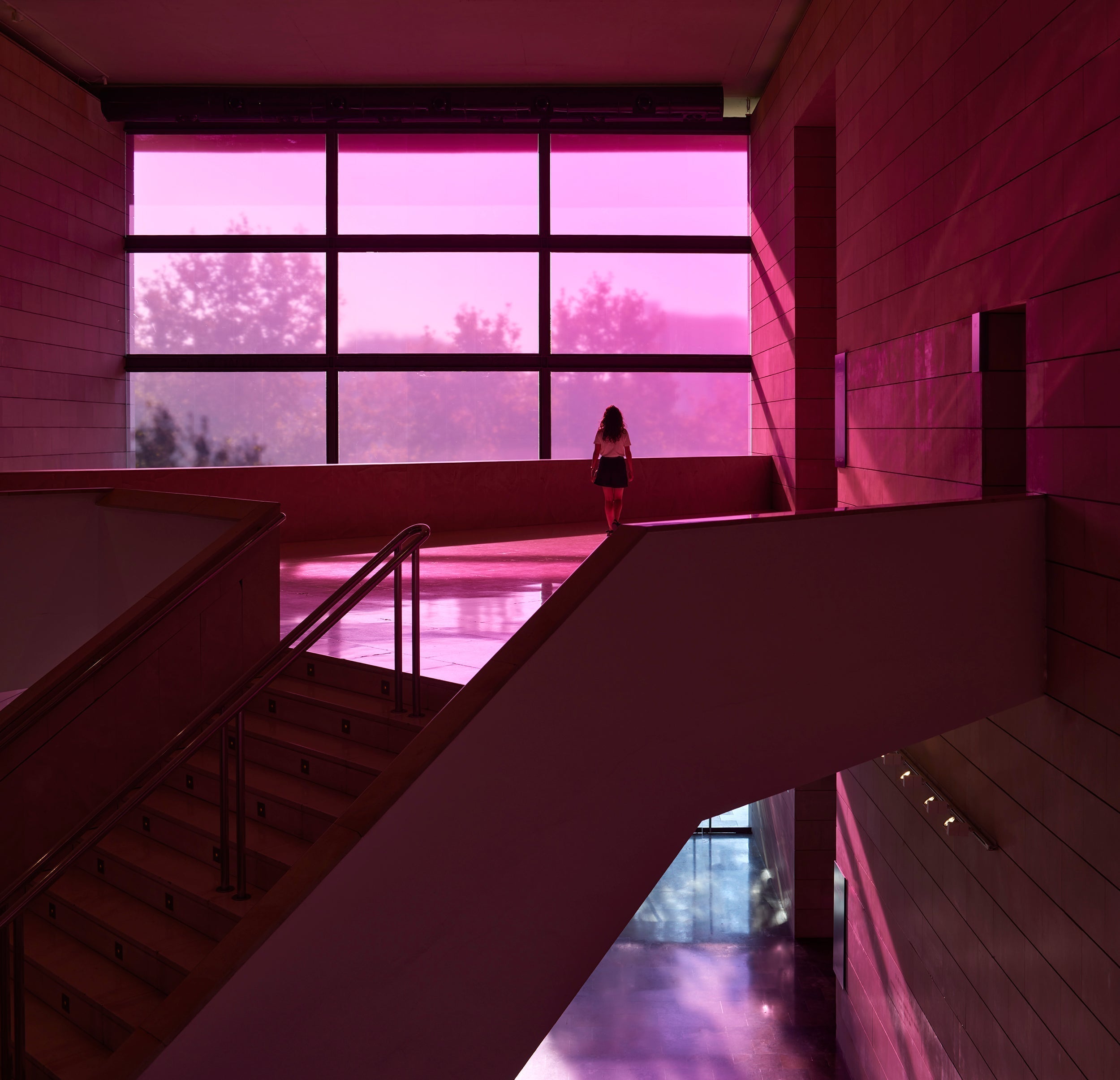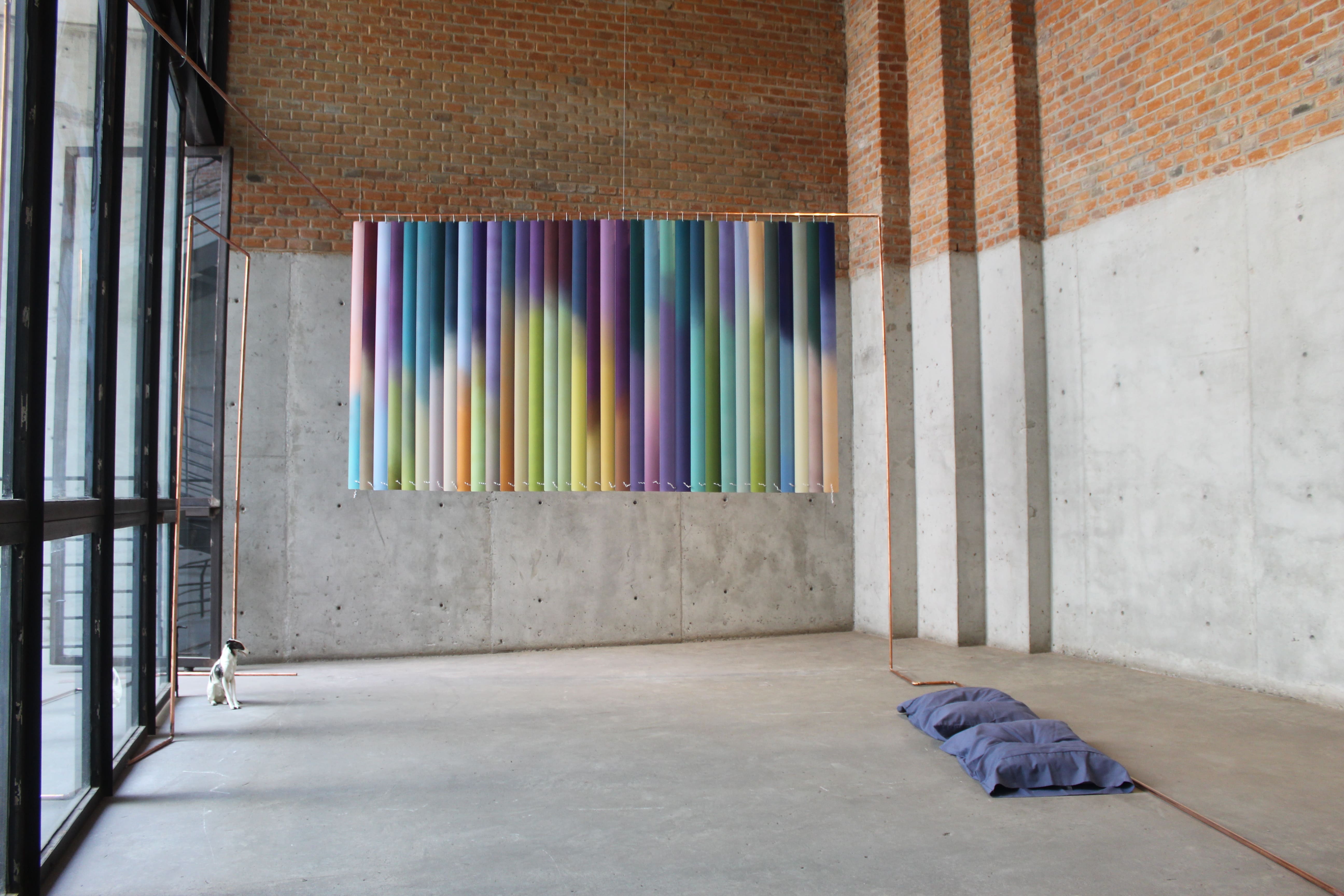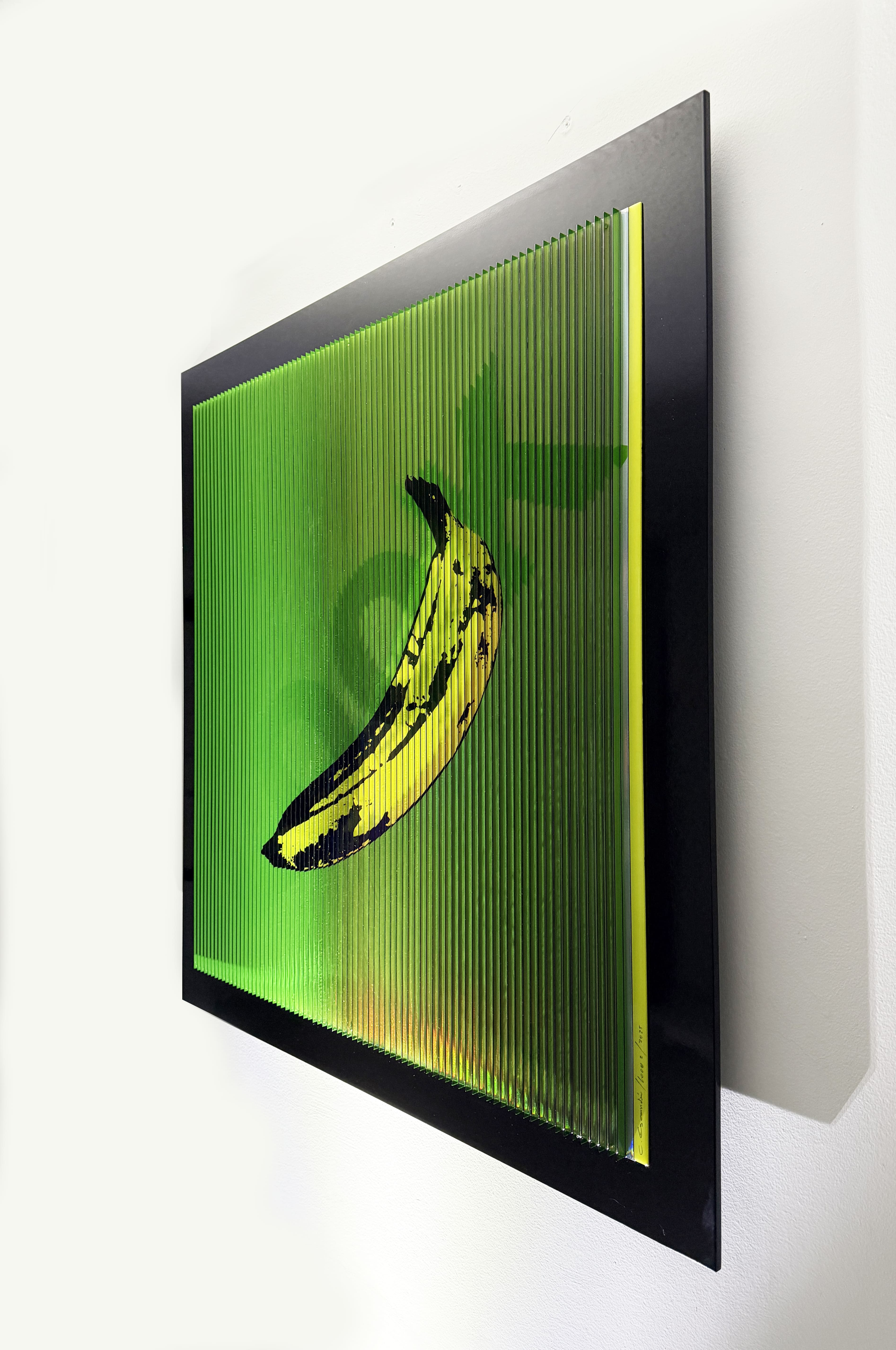Inma Femenía possesses the brilliant ability to conceive color in an atmospheric way: not only as matter, not only from the sensorial, not only from the metaphysical.
At the intersection of technology, perception, and emotion, the work of Inma Femenía (Valencia, 1985) unfolds as an ongoing investigation into light, not only as a physical phenomenon but also as a sensitive language. Initially trained in Fine Arts, her practice has been nourished by a constantly evolving approach, fueled by a close reading of contemporary art, her dedication to study, and influences such as James Turrell's work.
His work engages in a dialogue with immersive experiences of space, in an exercise that strips away ornamentation and focuses on the essential: how we see and how we feel. The experience of his installations, like Magenta Air at IVAM (2024), or Iris de Foc at the Liceu (2024) transforms spaces into dialogues that emerge from light and color as a way of sculpting the possibilities of the interior of spaces, as well as our own interior.
We spoke with Inma Femenía about light, sensoriality, the balance between physics and sensitivity, and her fascination with conveying what she feels.

Inma Femenía. "Magenta Air" installation, IVAM (2024). Photo: ©Mariela Apollonio
What is a typical day like for Inma Femenía?
A typical day starts with a leisurely breakfast, and by 9:30 a.m., I'm already in the studio planning my day while sipping on a cup of tea. First, I take care of any pending matters, then I dedicate the morning, distraction-free, to whatever phase of the project I'm currently in: conceptualizing, working on models, photographing, painting, or testing materials.
At 2:00 PM, I stop for lunch and, whenever possible, I go for a walk with Joaquima, my dog. In the afternoon, I return to the studio to finalize my work, and I usually finish the day around 7:00 PM, leaving everything ready for the next day.
You work in a very particular environment. It seems like every artist's utopian dream to be able to develop in a natural setting that offers spatial perspective and also clears our brains of stimuli. What influence does your environment have on your work? How does it influence it?
I'm very visual and observant, so my surroundings creep into my work without me even realizing it. One of the foundations of my work is light, and in Valencia, it's warm and intense, with nuances that make the colors shine in unique ways. Furthermore, living near the beach has taught me to pay attention to the reflections light creates on the water and how those glimmers change depending on the time of day. From this interplay of light and volume, my interest in exploring how light affects the physicality of objects and transforms the perception of forms was born .


Inma Femenía. "Magenta Air" installation, IVAM (2024). Photo: ©Mariela Apollonio
When we began researching artists working with color in Spain, your name was one of the first that came to mind. You work with light, understanding that it's the channel through which we perceive things, and color plays a central role in your work. Through it, you create atmospheres that transport us to other universes. How would you define the relationship between your work and color?
My work's relationship with color is born almost instinctively. I work with it as if it were matter, giving it body and physicality in each layer. For me, color is perception that entails experience. I conceive color as light materially present and as an expanding space; each beam of light generates atmospheres, adds depth, and sculpts volumes. In my most recent projects, I've explored this idea through air. For example, in the site-specific installation Aire Magenta at the IVAM and Iris de Foc at the Liceu , where the interplay of sunbeams and natural phenomena invites the visitor to immerse themselves in this sensorial experience.
My aim is to convey to the viewer the same fascination I feel for the phenomenon of color. I want them, when faced with my works, to experience a moment of wonder and contemplation, allowing themselves to be enveloped by the light and color.

Inma Femenía. Installation "Iris" by Foc Liceu (2024) ©David Zarzoso
How did you come to connect with color as a protagonist? What do you think happened within you, and where could we say these influences come from, consciously or subconsciously?
I think I connected with color very naturally, almost without realizing it. As a child, I was fascinated by pencil cases full of colors, from wooden pencils to watercolors. Squeezing the pencil to intensify the tone or seeing how a few drops of water turned the pigment into something almost translucent completely absorbed me. That curiosity led me to study Fine Arts, where I discovered that what truly attracted me wasn't so much pure color but rather light phenomena, the subtlety of a gradient, or the flashes of reflected light.
My perseverance in my studies, my reading of contemporary criticism, and the influence of works by artists such as James Turrell and Monet have cemented my work, both consciously and unconsciously.
Materials are often closely linked to and influence what is communicated. What role does material play in your work?
For me, the material is one of the starting points for shaping color. I work with color in a very physical way, and to give it that tangibility, I carefully choose the material and the surface.
One of the books that has influenced me most in this regard is Surface by Giuliana Bruno, which explains that surfaces, such as walls, screens, or fabrics, are not just supports but also influence what we see. Each one lets light through differently and provides visual and tactile sensations. Similarly, in my work, I select the right materials to create the atmosphere I'm looking for.


Inma Femenía. Installation More Light! (2020). Photo Mariela Apollonio and Jabalí Studio.
You're featured in the book Women Light Artists as one of the 40 most influential women artists and designers for your work with light. What was it like to find comfort in working with light? What does giving prominence to light and color offer that other mechanisms you've explored before don't offer in your work?
Light is one of the most complex materials to work with and, at the same time, one of my favorite tools. I've become increasingly comfortable working with it and incorporating it into my projects; it's been a gradual and intuitive process.
After years of trial and error in the studio, I learned to understand its qualities and see how it transforms each surface to generate color . Furthermore, collaborating with physicists, lighting technicians, and engineers was key; their specialized perspective has enriched the projects I've developed.
I have realized that, to create direct and immersive experiences, nothing
It works just as well as light. It occupies the space and bounces off surfaces, revealing nuances that envelop the viewer and make them an active part of the work. A good example is my installation Mehr Licht! , where an LED screen illuminates a wall and consequently the space, completely reconfiguring the way we usually perceive this color-light. I believe that these types of interventions offer the audience the opportunity to immerse themselves in an emotional and physical experience .


Inma Femenía. Installation More Light! (2020). Photo Mariela Apollonio and Jabalí Studio.
Over the years, you've probably noticed a myriad of viewer reactions to color. How does the viewer's subjective perception influence the way you create your work? How can the viewer's cultural or social context alter their perception of your work, and how do you take this into account in your artistic process?
In my creative process, I'm not limited by the viewer's subjective perception, which will always vary. I'm guided by the original motivation for the project and express it directly, so that each person connects with the work through their own unique sensitivity . I'm interested in the movements, journeys, and spontaneous reactions I observe in the viewers of my works.
One of the primary reasons we created CACO is that, through our research, we perceived a lack of cultural education regarding color. As an artist who specializes in this field, but also as a disseminator and trainer, what level of education about color, and color culture in general, do we face? Because, although your work seeks to move rather than be understood, do you think that's what the viewer is used to? Do you often feel a gap between what you seek to convey with your work from your perspective and what is understood about it due to a lack of color education?
We live surrounded by chromatic stimuli and have an innate intuition for perceiving nuances and interpreting the effect of color in our environment. Still, I agree that some training focused on color sensitivity may be lacking. For example, children are the most accustomed to experimenting with color, exploring and playing without prejudice. In the case of adults, I believe this sensitivity is lost if it is not cultivated, both in a playful and unconscious way and through greater education in the science behind color and perception .
Art plays a key role here: by bringing the public closer to a work, we sharpen their gaze and strengthen their ability to feel and understand color.
 Inma Femenía. Installation More Light! (2020). Photo Mariela Apollonio and Jabalí Studio. Courtesy of Inma Femenía
Inma Femenía. Installation More Light! (2020). Photo Mariela Apollonio and Jabalí Studio. Courtesy of Inma Femenía
Speaking a bit about the context in which we operate as women, what do you feel is the current situation for women in the art sector? What new opportunities, but also what limitations still persist in the sector?
Currently, the artistic community is making a valuable effort to revise the canon and give visibility to creators who were previously marginalized. We are seeing works by women artists, both historical and contemporary, being incorporated into public and private collections, and institutions are programming exhibitions that reclaim this lost legacy.
I'm part of a collective effort with my colleagues, which gives us the strength to move forward together, open up new opportunities, and continue to break down structural limitations.

Inma Femenía. "Magenta Air" installation, IVAM (2024). Photo: ©Mariela Apollonio
There's been an evolutionary process in your professional career, from creating more compact, medium-sized pieces a few years ago to intervening in large spaces with installations that transcend their intended purpose (you've intervened in the halls of cultural buildings, museums, theaters, and fashion shows). In what vein do you feel most comfortable as an artist, and where is Inma Femenía headed in the future?
I don't have a set path, but I feel especially comfortable with large-scale interventions and site-specific installations. I'm passionate about the research phase: entering a space, studying it, understanding its light, its architecture, and the flow of people, and then deciding what to add to enhance its character. That's why I want to continue developing projects that establish a dialogue between the work and the place, without closing the door to new proposals or formats.
Credits:
Photos courtesy of Inma Femenía
Thanks to Inma Femenía



